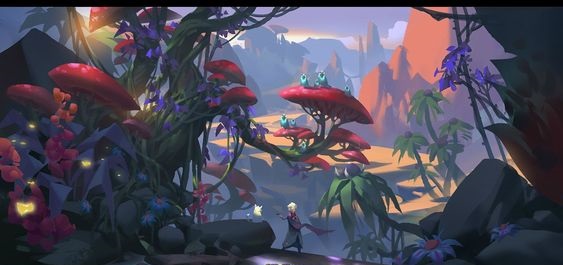Animism
Sometimes derisively called "Nature Worship" by non-believers, Animism refers to the belief in natural spirits and local gods that more resembles a philosophy than an organized religion. Animists do not view themselves as members of a faith, usually seeing their beliefs as just apart of their cultural background. The term is an umbrella that lumps together Wendikal hunter societies, aspects of Chult culture and ancient Shivra polytheism. Sill, there are pleanty of overlap between these belief systems that the term finds wide use across Ur'En.
Animism has no over-arching hierarchy and no universal canon, so exact beliefs differ, sometimes greatly, from one region to the next. Many of the entities within animism are localized as well, meaning the spirit of a particular mountain might be unheard of to those in distant lands. What is fundamental to animists is the belief that they are a part of the natural order, not separate from it, and that inanimate objects as well as animals have magical anthropomorphic aspects to them like personalities and goals. These are often interwoven with stories and legends to create a tapestry of mythology.
Animism is the undisputed law of the wilds, holding sway in large swaths of the The Howling Woods, Corsair's Coast and Rajjahid Jungle. Even the settled peoples in rural communities will say a prayer to the river god, or recount the legend of Father Dis to their children.
Animism has no over-arching hierarchy and no universal canon, so exact beliefs differ, sometimes greatly, from one region to the next. Many of the entities within animism are localized as well, meaning the spirit of a particular mountain might be unheard of to those in distant lands. What is fundamental to animists is the belief that they are a part of the natural order, not separate from it, and that inanimate objects as well as animals have magical anthropomorphic aspects to them like personalities and goals. These are often interwoven with stories and legends to create a tapestry of mythology.
Animism is the undisputed law of the wilds, holding sway in large swaths of the The Howling Woods, Corsair's Coast and Rajjahid Jungle. Even the settled peoples in rural communities will say a prayer to the river god, or recount the legend of Father Dis to their children.
Structure
Animism has only the barest semblance of structure and hierarchy. Elders who are wise in the ways of the spirits guide those around them. Disputes between elders are settled with words, violence or appeals to the spirits for answers.
History
Animist advocates will often proclaim that at one time, all peoples revered the spirits. Then, the children of the land became prideful and arrogant and abandoned the old ways in favor of new Gods. The historicity of this claim is dubious, however it speaks to a certain truth, namely that animism has been on a slow decline since the rise of cities and empires. Animism has few converts and those not born into its belief structure often find it unattractive. Its members also cannot out-compete or out-breed their competition, with settled peoples able to muster more resources both to feed a growing population and defeat animist cultures on the field of battle. This has meant that animism is either eradicated, abandoned or integrated into organized religions.
Priesthood
Animists are led by local Shaman, Druids and Witch-Doctors. These are often older, powerful spell-casters, though exceptions exist. All that is required to be an authority is to be seen as a wise source of council and knowledge.
Granted Divine Powers
The powers said to be granted by Animist spirits very greatly. Many are centered around control of plants and animals. Others are given domain over healing while others are granted influence over the elements. These powers come either from a paticular revered spirit or are said to be granted by Ur itself.
Type
Religious, Druidic Circle
Alternative Names
Nature Worship, "Treehuggary"
Demonym
Animist
Remove these ads. Join the Worldbuilders Guild










Comments